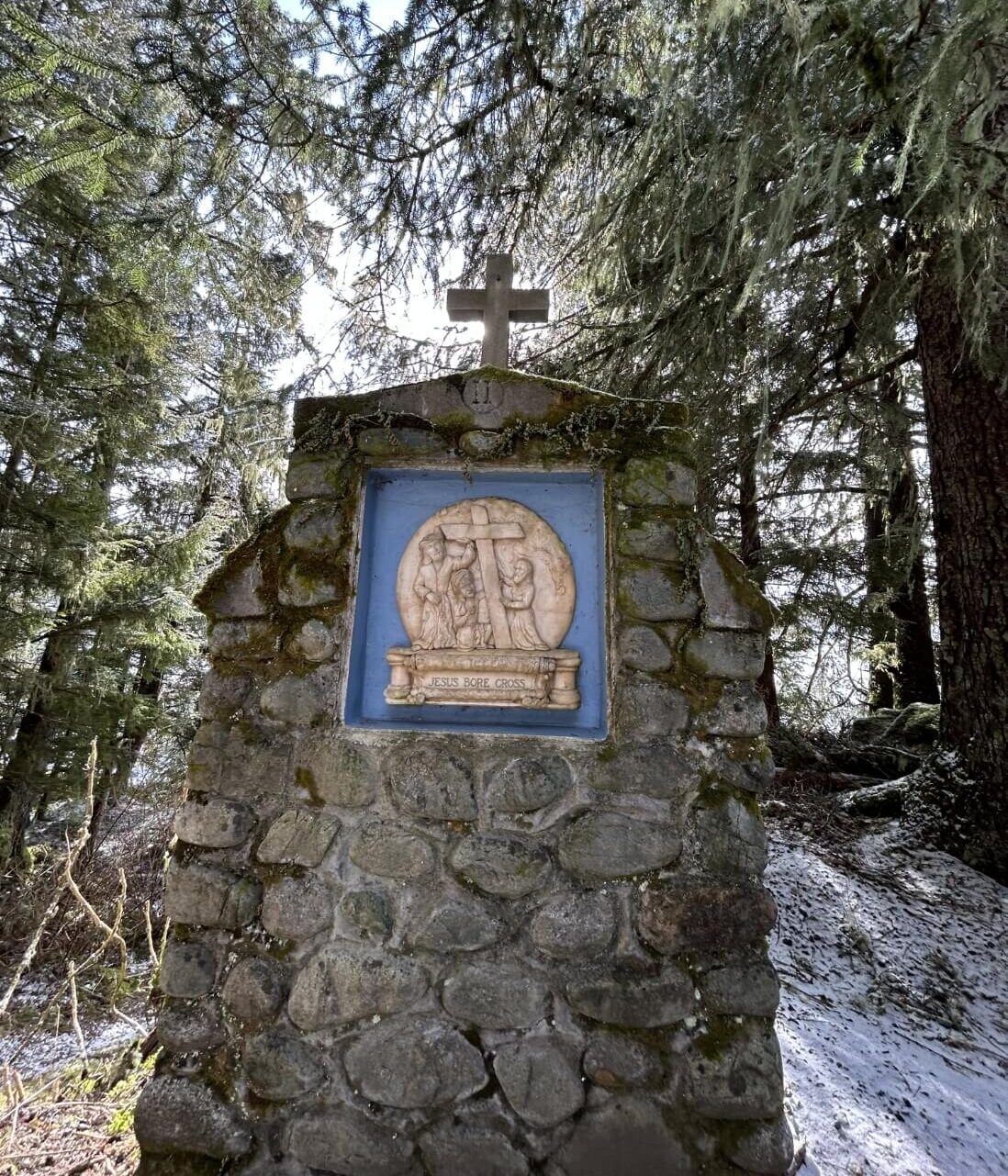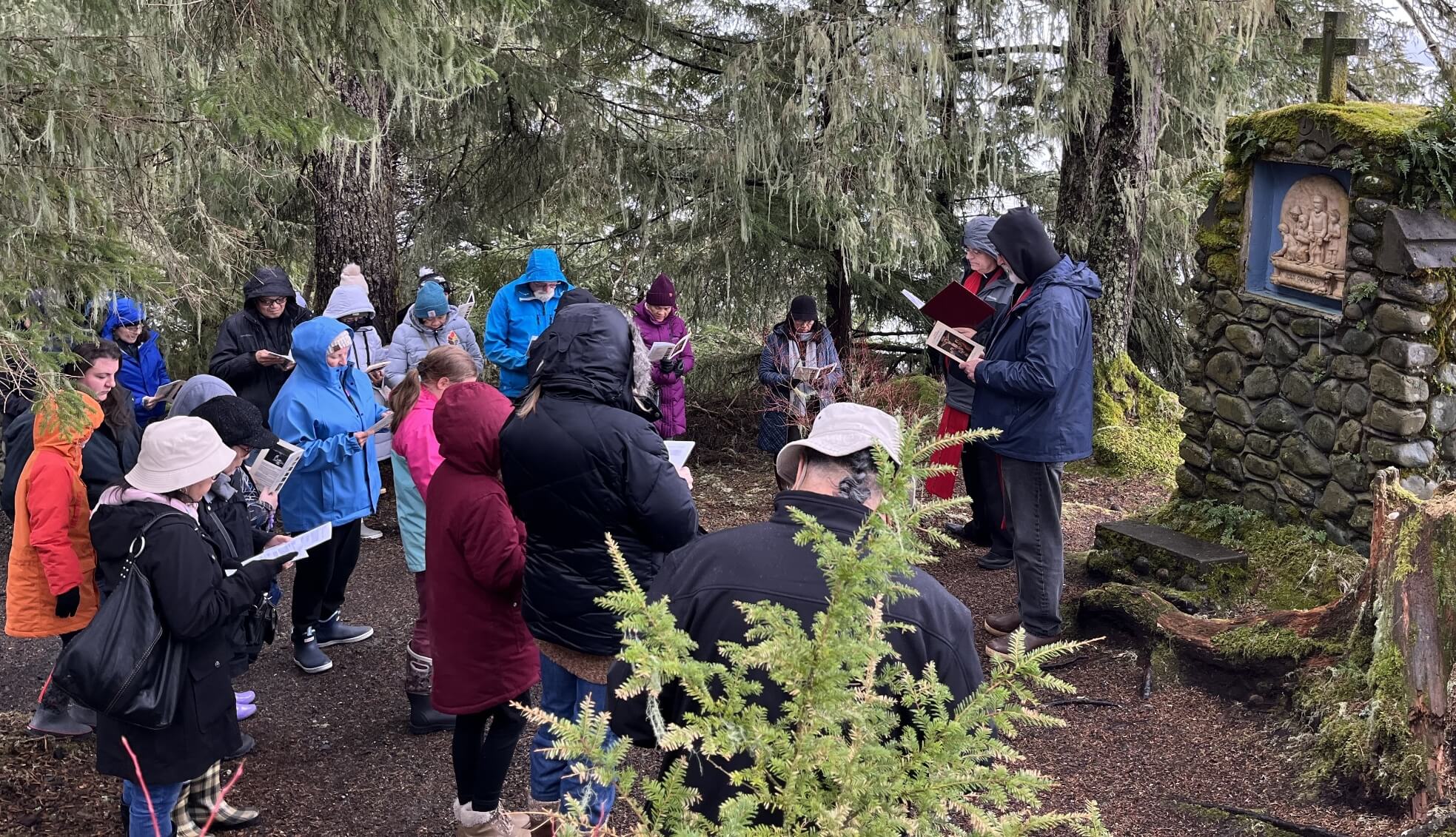Stations of the Cross
History in Stone
Like the chapel, the Shrine’s Stations of the Cross were built from beach rock gathered by volunteers and then assembled with mortar. The stations circle Shrine Island and are linked by a trail running counterclockwise. The stations were constructed in the early 1940s. Resin sculptures, created by R.D. Robinson, replaced the original glass-covered images in the 1980s.
The devotional exercise of visiting and praying in front of each of the stations and meditating on the Passion of Christ stems from the practice of early Christian pilgrims, who visited the scenes of the events in Jerusalem and walked the traditional route from the supposed location of Pilate’s house to Calvary. Tradition holds that Mary, the mother of Jesus, set up stone markers at her home outside Jerusalem to prayerfully retrace the steps of her son’s Passion.


The Story Behind the Stations of the Cross Sculptures
From the earliest of times, human beings have set aside unique places of spiritual significance to help them open up to the presence of God. The Stations of the Cross, also known as “The Way of Sorrows,” is a devotion beloved by most Catholics and others who understand the depth of meaning in the ritual. The origin of this devotion can be traced back to the early days of the Church. The faithful naturally venerated the chief scenes of our Lord’s suffering and death and traveled great distances to visit the places made sacred by the Passion of Christ.
Following the conquest of Palestine by the Mohammedans, Christians experienced great difficulty visiting the sacred sites. So it was that the Church in various localities devised the form of devotion known as the “Way of the Cross” or the “Stations of the Cross.” Inspired artists, sculptors, and painters began depicting each incident along the Way of Sorrows. Such representations were often placed along roads leading to churches or in the grounds surrounding them. In this way, the people could make devout pilgrimages to commemorate certain events in the last hours of Christ’s earthly life.
Still later, similar representations were set in the churches’ walls, so these devotions might more easily be continued. The number of traditional stations, which at first varied widely, finally became fixed at fourteen. Contemporary Christians often conclude by focusing on the Resurrection as a fifteenth station. Of these, nine are based directly on events recorded in the Gospels. The remaining six (numbers 3,4,6,7,9, and 13) are based on inferences from the Gospel accounts or spiritual tradition.
Sculpting the Narrative at the Shrine
Surrounding the Shrine of St. Therese Chapel and built in the same style as the Chapel walls – mortar and beach stone – are fifteen Station of the Cross structures. Fourteen of these formations were constructed under the supervision of Doc Holden, the stonemason who orchestrated the construction of the Shrine Chapel. The fifteenth form was completed by Greg Mallinger, a local Juneau stonemason, and his family in 1992.
Initially, in the 1940s, each Station form contained a picture protected by glass of each scene of Christ’s journey to crucifixion. The damp climate penetrated these images, and in 1966, a plaster cast set of figures was set in place. Again, the elements began to erode the plaster. In 1986, a young junior high school student, J.J. Sweigart, met R.D. Robinson, a local Juneau artist, through the Juneau Public School District’s “Artist in Residence” program. One day, while working on classroom art, Sweigart approached Robinson about repairing the damaged station sculptures at the Shrine.
R.D. visited Shrine Island and after seeing the poor condition of the sculptures, decided not to repair or refurbish the deteriorated works but to redo the entire set of sculptures. After compiling a portfolio of his past work and a plan for 14 new station scenes, Robinson met with the Shrine Committee and shared his ideas. Fully aware of the very limited Shrine budget, which was earmarked for leaky roofs and facility repairs, the committee members endorsed Robinson’s idea if donors for the project could be found. Two anonymous donors funded the complete plan at a price that was slightly less than $40,000. The generous donors were revealed after their deaths to be Vera Carrigan, who died in 1991, and Mary Toner, who died in 1993.
A Testament in Detail
Cast of alabaster with a hint of onyx, the faces of the stations are done in what Robinson describes as a contemporary Renaissance style. In reminiscing about the project, Robinson called it one of the “most intricately detailed sculpturing” works he’d ever done. His goal for this extensive project was to achieve a three-dimensional effect that would make viewers feel as if they could reach around each image; to add to that effect, Robinson created facial expressions that present the figures as though they are making eye contact with each other and their viewers. He shared how he prepared by visiting the Holy Land, researching Scriptures for a Biblical basis for the Passion of Jesus before designing each set, and studying human anatomy in depth so that intricate details could be included in the sculptures.
"It was a challenge to do the pieces since the scenes are so very relentless. Each scene has a great deal of facial detail, with Christ in agony in so many. It is a monumental challenge to sculpt sadness, contempt, all the wounds, and just a host of human emotions in sculpture."
R.D. Robinson
Ready to Explore the Shrine?
Download our campus map to guide your exploration through the sacred sites.
Volunteers, the Backbone of the Shrine!
From the beach stones gathered that make up the walls of the Shrine Chapel to the plants that grace the Marian and Biblical Gardens, all are the work of volunteers giving their time for the greater glory of God. Are you being called to this work?